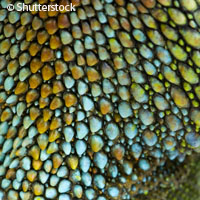Fossilised reptile skin sheds its secrets
Scientists have detected protein residues from the skin of a 50-million-year-old fossilised reptile. Crucially, the team achieved this feat without destroying the sample. As well as providing palaeontologists with a tool to study samples too precious or rare to be destroyed, the study could shed light on the fate of waste that is buried for a long time. The work is published in the journal Proceedings of the Royal Society B. When most people think of fossils, they think of hard structures like bones and shells. However, a number of recent studies have demonstrated that some soft tissues may also be preserved during fossilisation. The problem is that analysing this soft tissue entails the destruction of part of the sample. In this study, scientists in the UK and the US proved that it is possible to detect and identify the remnants of soft tissue in fossils without destroying the sample. The subject of the researchers' analyses is a 50-million-year-old fossilised reptile found in the rocks of the Green River Formation in the US state of Utah. The sample was investigated using an infrared technique called Fourier transform infrared (FTIR) spectrometry. The infrared light causes vibrations in the fossilised skin, and the researchers used a relatively simple trick to map these vibrations. The infrared beam is shone through a tiny crystal; much of the light is reflected off the base of the crystal, but a small amount goes beyond the crystal and into the fossil below. Any organic compounds present in the fossil absorb some of the infrared beam and change the signal that is reflected back to the system. By moving the beam and crystal systematically across the surface of the fossil, the team was able to create a map of the organic compounds detected. The team also studied the skin using another technique called synchrotron rapid scanning X-ray fluorescence (SRS-XRF). To gauge the accuracy of their findings, the researchers studied modern lizard skin as well and used conventional techniques to study the ancient sample; these involved destroying a part of it. 'The mapped distributions of organic compounds and trace metals in 50-million-year-old skin look so much like maps we've made of modern lizard skin as a check on our work, it is sometimes hard to tell which is the fossil and which is fresh,' commented Dr Roy Wogelius, a geochemist from the University of Manchester in the UK. 'These new infrared and X-ray methods reveal intricate chemical patterns that have been overlooked by traditional methods for decades.' The high level of chemical detail revealed by the analyses allowed the scientists to propose how the ancient skin was preserved. When the original compounds in the skin start to break down, they form chemical bonds with trace metals, which act as a kind of 'bridge' to minerals in the sediments. This effectively prevents the skin material from being washed away or decomposing further, the researchers suggest. 'Taken together, all the analyses performed in this study strongly suggest that the fossilised reptile skin in [the sample] is not a simple impression, mineralised replacement or an amorphous organic carbon film, but contains a partial remnant of the living organism's original chemistry, in this case derived from proteinaceous skin,' they write. 'We conclude that it is now possible to non-destructively map organic compounds and reveal the chemistry of biological structures preserved from fossil organisms up to at least 50 [million years] old,' they add. 'This opens up new applications for FTIR imaging in the science of palaeontology such as performing organic analyses of rare specimens where destructive sampling is not possible.' 'The ability to chemically analyse rare and precious fossils such as these without the need to remove material and destroy them is an important and long overdue addition to the field of palaeontology,' concludes the first author of the paper, Nick Edwards of the University of Manchester. 'Hopefully this will provide future opportunities to unlock the information stored in other similarly preserved specimens.' His colleague Phil Manning added: 'Here physics, palaeontology and chemistry have collided to yield incredible insight into the building blocks of fossilised soft tissue. The results of this study have wider implications, such as understanding what happens to buried wastes over long periods of time. The fossil record provides us with a long-running experiment, from which we can learn in order to help resolve current problems.'For more information, please visit: University of Manchester:http://www.manchester.ac.ukProceedings of the Royal Society B:http://rspb.royalsocietypublishing.org/
Countries
United Kingdom, United States

